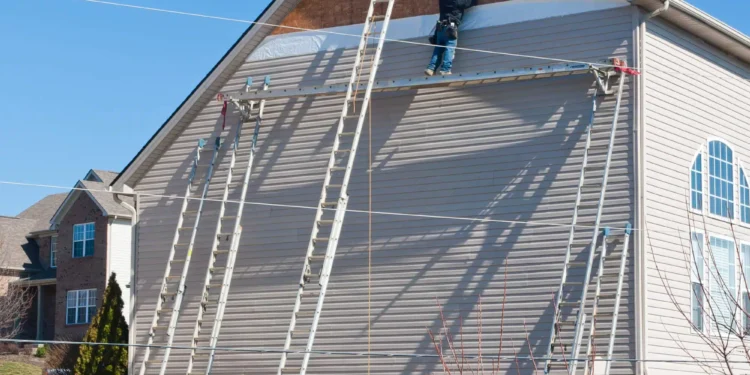Embarking on the journey of installing siding and roofing requires the right set of tools to ensure a successful project. From essential equipment to innovative gadgets, this guide explores everything you need to know about the best tools for the job.
As we delve deeper into the specifics of siding and roofing installations, you'll discover valuable insights on tool functions, safety measures, and the latest technological advancements shaping the industry.
Best Tools for Siding Installation
When it comes to installing siding, having the right tools can make the job much easier and more efficient. Here are some essential tools you'll need for siding installation:
Siding Nail Gun
- A siding nail gun is a must-have tool for quickly and securely attaching siding to the exterior of a building.
- It allows for precise placement of nails and ensures a professional finish.
- Make sure to adjust the nail depth to prevent damage to the siding material.
Siding Cutters
- Siding cutters are essential for cutting the siding panels to the correct size and shape.
- They provide clean and accurate cuts, ensuring a seamless look when installing siding.
- Always wear protective gloves when using siding cutters to prevent injuries.
Ladder or Scaffolding
- A sturdy ladder or scaffolding is necessary for reaching higher areas when installing siding.
- Ensure the ladder is stable and secure before climbing to prevent accidents.
- Use caution when working at heights and always follow safety guidelines.
Level Tool
- A level tool is essential for ensuring that the siding is installed straight and level.
- Use the level tool frequently during installation to maintain a uniform appearance.
- Adjust the siding as needed to achieve a straight and level finish.
Tin Snips
- Tin snips are useful for cutting metal siding materials with precision.
- They allow for intricate cuts and curves, making them ideal for custom installations.
- Always wear eye protection when using tin snips to avoid eye injuries from flying debris.
Best Tools for Roofing Installation
When it comes to roofing installation, having the right tools is crucial to ensure a successful and efficient project. Let's take a look at some of the must-have tools for roofing projects and discuss the differences between tools used for different types of roofing materials, as well as safety measures to consider when using these tools.
Must-Have Tools for Roofing Projects
- Roofing Hammer: A specialized hammer with a claw on one side for removing nails and a flat head for driving nails into the roofing materials.
- Roofing Nailer: A pneumatic tool that is used to quickly and efficiently nail down roofing materials, such as shingles or tiles.
- Roofing Knife: A sharp utility knife used for cutting roofing materials to size and shape.
- Roofing Shovel: A tool with a flat blade that is used to remove old roofing materials during a roof replacement project.
- Roofing Safety Harness: Essential for working on roofs at heights, providing fall protection for the roofer.
Differences Between Tools for Different Roofing Materials
- For Asphalt Shingles: Tools like a roofing nailer and roofing knife are commonly used due to the ease of installation of asphalt shingles.
- For Metal Roofing: Tools such as metal snips and a metal roofing hammer are essential for cutting and securing metal roofing materials.
- For Tile Roofing: Tile cutters and a tile roof hook are often used to cut and install tile roofing materials safely and accurately.
Safety Measures When Using Roofing Tools
- Always wear appropriate safety gear, including gloves, safety glasses, and a hard hat, to protect yourself from potential injuries.
- Ensure that all tools are in good working condition before starting any roofing project to prevent accidents or malfunctions.
- Use caution when working on roofs at heights and always secure yourself with a roofing safety harness to prevent falls.
- Follow proper ladder safety protocols when accessing the roof, ensuring that the ladder is stable and secure before climbing up.
Comparison of Manual vs. Power Tools
When it comes to siding and roofing installation, the choice between manual and power tools can greatly impact efficiency, speed, and cost-effectiveness of the project. Let's explore the advantages and disadvantages of each to help you make an informed decision
.
Manual Tools
Manual tools have been used for centuries in construction projects, and they still hold value in certain situations. Here are some key points to consider:
- Advantages:
- Cost-effective: Manual tools are generally more affordable upfront, making them a good option for those on a tight budget.
- Precision: Some tasks may require the finesse that manual tools provide, allowing for more precise cuts or adjustments.
- No need for power source: Manual tools do not rely on electricity or batteries, making them ideal for remote job sites or areas with limited power access.
- Disadvantages:
- Labor-intensive: Using manual tools can be physically demanding and time-consuming, especially for larger projects.
- Limited efficiency: Manual tools may not be as efficient or fast as power tools, which can impact overall project timelines.
- Skill level required: Some manual tools require a higher level of skill and experience to use effectively, which may be a barrier for beginners.
Power Tools
Power tools have revolutionized the construction industry with their speed and efficiency. Here's why many professionals opt for power tools in siding and roofing projects:
- Advantages:
- Speed: Power tools can significantly speed up the installation process, allowing for quicker project completion.
- Efficiency: Power tools are designed to streamline tasks and reduce labor intensity, increasing productivity on the job site.
- Versatility: Power tools come in a variety of types and sizes to suit different tasks, providing flexibility in project execution.
- Disadvantages:
- Cost: Power tools can be more expensive than manual tools, requiring a higher initial investment that may not be feasible for all budgets.
- Dependency on power source: Power tools need electricity or batteries to operate, which can be a limitation in remote areas or during power outages.
- Training required: Using power tools safely and effectively often requires training or experience, adding a learning curve for some users.
Innovative Tools for Modern Siding and Roofing
As technology continues to advance, new tools and gadgets are being developed to streamline the process of siding and roofing installation. These innovative tools are designed to enhance efficiency, improve work quality, and make the job easier for construction professionals.
Robotic Siding and Roofing Installers
One of the most revolutionary advancements in the construction industry is the development of robotic siding and roofing installers. These machines are equipped with sensors and precision technology to accurately measure, cut, and install siding and roofing materials with minimal human intervention.
Robotic installers can work faster and more accurately than manual labor, reducing the risk of errors and increasing productivity on the job site.
Drones for Roof Inspections
Drones are also being utilized in the roofing industry for conducting inspections of roofs. These unmanned aerial vehicles can capture high-resolution images and videos of roofs, allowing inspectors to identify any damages or issues without having to physically climb onto the roof.
Drones provide a safer and more efficient way to assess roof conditions, leading to quicker repairs and maintenance.
3D Modeling Software for Siding Design
3D modeling software is another innovative tool that is transforming the way siding is designed and installed. This software allows contractors to create detailed 3D models of buildings, enabling them to visualize how different siding materials and designs will look before installation.
By using 3D modeling software, contractors can make more informed decisions, reduce material waste, and ensure a precise fit for siding materials.
Final Summary
In conclusion, equipping yourself with the best tools for installing siding and roofing is not just about having the right gear. It's about efficiency, safety, and staying abreast of cutting-edge technologies that can elevate your craftsmanship to new heights. Use this guide to navigate the world of siding and roofing installations with confidence and precision.
FAQ Corner
What are the specific functions of siding installation tools?
Siding installation tools serve various purposes such as cutting, measuring, nailing, and fastening siding materials securely in place. Each tool plays a crucial role in achieving a seamless and durable finish.
How do power tools differ from manual tools in roofing projects?
Power tools offer faster operation and increased efficiency compared to manual tools. They are ideal for large roofing projects where speed and precision are key factors. However, manual tools provide more control and are often preferred for intricate or detail-oriented tasks.
Are there any safety precautions to consider when using roofing installation tools?
Safety is paramount when using roofing installation tools. Always wear appropriate protective gear, secure ladders properly, and follow manufacturer instructions for tool operation to minimize the risk of accidents or injuries.








